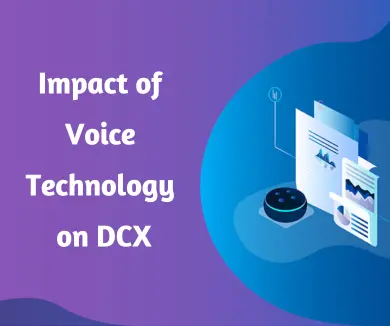Introduction
In a world where technological advancements are racing ahead like a supersonic jet, one innovation has captured our attention and transformed the way we interact with digital interfaces – Voice Technology. It’s more than just a convenient tool for hands-free tasks; it’s a game-changer that’s revolutionizing the world of Digital Customer Experience (DCX). So, grab your sonic glasses and let’s dive into the impact of voice technology on the way we engage, connect, and experience the digital world.
According to a report by Voicebot.ai, transactions through Voice Assistants will reach $19.4 billion by 2023.
The Rise of Voice Assistants
Imagine it’s Monday morning and you’re scrambling to get ready for work. Instead of tapping away at your smartphone, you simply ask, “Hey, Alexa, what’s the weather today?” In an instant, you’re informed and ready to tackle the day. This level of causal interaction has increased with voice assistants becoming our digital friends.
Reshaping Customer Engagement
Beyond the laid-back queries, voice technology is charting new territories in customer engagement. Brands have recognized its potential to transform interactions into meaningful experiences. A study conducted by PwC reveals that 32% of consumers believe voice technology will become a regular part of their daily lives within the next three years. This paradigm shift forces companies to adapt, with 72% of businesses investing in voice technology to improve their customer experience.
The Interesting World of Vocal Identity
Imagine ordering your favorite meal from a restaurant, and the virtual assistant taking your order sounds as warm and familiar as an old friend. That’s the power of vocal identity. Voice technology enables brands to create unique personas that resonate with their customers. According to a report by Juniper Research, the voice commerce market is expected to reach $80 billion by 2023. This means that brands are not just selling products but also making memorable experiences, leaving an indelible mark on customers’ minds.
Voice Technology and Inclusion
The impact of voice technology goes beyond convenience and permeates the areas of accessibility and inclusion. The World Health Organization estimates that approximately 15% of the world’s population experiences some form of disability. Voice-driven interfaces are bridging this gap, providing a space for those with disabilities to navigate the digital sphere effortlessly. The American Foundation for the Blind highlights that 62% of visually impaired adults believe voice assistants have greatly improved their quality of life.
Learning from Every Remark
What if your digital assistant could anticipate your needs before you even express them? Voice technology is making that a reality. The more we interact, the more these systems learn. This constant feedback loop enhances user experiences and aids companies in refining their offerings. A study by Adobe Analytics indicates that 91% of businesses using voice technology have seen an improvement in customer satisfaction, underscoring the value of this ongoing learning process.
The Financial Resonance of Voice Commerce
Voice technology isn’t just a convenience; it’s a profitable avenue for businesses. In fact, the voice commerce market was $40 billion in the US alone in 2022, as revealed by OC&C Strategy Consultants. This data underscores the seismic financial impact that voice technology has on e-commerce, as more consumers embrace the ease of making purchases through voice commands.
Voice Technology in Healthcare
The influence of voice technology reaches far beyond convenience. In healthcare, voice-enabled solutions are making waves. A report by Nuance Communications states that 89% of physicians believe that voice recognition solutions have significantly improved patient documentation. This formal transformation streamlines healthcare processes, allowing professionals to focus more on patient care and less on paperwork.
Driving Business Productivity
Voice technology isn’t just impacting customer-facing interactions; it’s also reshaping internal business operations. In fact, a survey by Spiceworks found that 58% of businesses believe voice technology will become essential for employee productivity within the next few years. From scheduling meetings to drafting emails, voice commands streamlining tasks, freeing up valuable time for more strategic endeavors.
A Voice-Activated Lifestyle
Voice technology has seamlessly integrated into our daily lives and has become an integral part of modern life. In fact, a recent Voicebot.ai survey found that 72.6 million adults in the US own a smart speaker, reflecting the technology’s widespread adoption. From setting the morning alarm to checking traffic updates, voice assistants have effortlessly integrated into our lives, creating a conversational, casual digital experience.
Corporate Integration and Savings
The influence of voice technology is not limited to households; it’s reshaping corporate landscapes too. A study by Cognizant reveals that voice technology is projected to save businesses up to $2 trillion by 2023. Enterprises are leveraging voice-powered solutions to enhance employee efficiency, optimize supply chains, and improve customer support, leading to substantial cost savings and operational improvements.
Voice Interfaces with Emotional Intelligence
It’s not just about responding to commands; voice technology is learning to detect emotions and respond accordingly. The deployment of emotional AI is on the rise, allowing voice assistants to gauge the mood of users and tailor responses accordingly. This emotional connection enhances customer experiences, making interactions feel more human. Gartner predicts that by 2025, at least 10% of customer interactions with AI will involve an emotional engagement aspect.
Voice as the New Biometric
As cybersecurity becomes more important, voice technology is becoming a powerful authentication tool. Voice biometrics analyze unique voice patterns to provide a secure and convenient method of authentication. A MarketsandMarkets report predicts that the voice biometrics market will reach $3.9 billion by 2026. This evolution highlights the potential of voice technology not only to transform DCX, but also to enhance digital security.
Voice-Driven Content Consumption
The entertainment industry is tapping into the potential of voice technology to reshape the way we consume content. Smart speakers have become personalized entertainment hubs, allowing users to access news, podcasts, music and audiobooks with a simple voice request. A study by Edison Research and NPR revealed that 53% of smart speaker owners regularly use them to listen to audio content, pointing to the growing role of voice in entertainment.
The AI Voice Revolution
The trajectory of speech technology heralds a future in which AI-generated speech will be indistinguishable from human speech. For example, OpenAI’s GPT-3 can produce very human-like voices. This opens up possibilities for hyper-personalized interactions and content creation. The World Economic Forum predicts that by 2025, half of the world’s internet searches will be voice-based, signaling a sea change in how we navigate the digital realm.
Conclusion
You now understand the impact of voice technology on how we experience the digital world. It’s like a cool new gadget that lets us talk to machines and get things done with ease. But it’s not just about convenience; it’s about convenience. As a result, businesses save a lot of money and increase efficiency.
Guess what? Our voices are becoming the secret key that keeps our digital assets safe. Plus, machines are getting smarter and can even understand how we feel — that’s some next level thing.
The entertainment industry is also shifting. Our voices are ready to play music, news or stories – it’s like having a personal DJ at home.
Looking ahead, things will get even crazier. Soon, machines may sound just like us, which will change the way we talk to them. It’s like the beginning of a new chapter in the tech world, where our voices are the stars.
So keep talking, keep exploring, and get ready for more voice adventures. It’s a cool tech ride, and we’re all a part of it.



